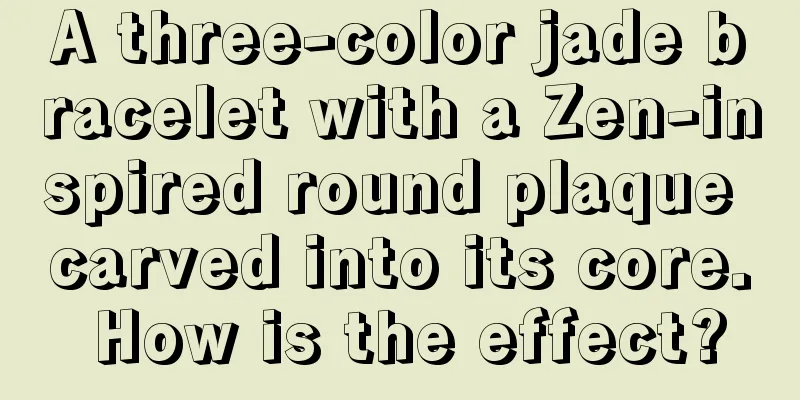How to easily distinguish whether jadeite is grade A or grade B? Is there any reliable method?

|
The following article will briefly introduce several simple identification methods. Identification of Grade A Jadeite (I) Check for impurities. Since jade is formed in nature, if it is A-grade jade, it is bound to have some impurities, such as black, yellow or gray bodies, while processed B-grade jade has very few impurities because they have been corroded by strong acids. Emerald Roots Look at the color root. The so-called color root refers to a point or a thin strip of slightly darker green in jade jewelry. These slightly darker greens gradually transition into relatively lighter greens and are called color roots. The color and base of natural A-grade jadeite are naturally coordinated, with the green color distributed like tree roots or flakes, and the outline is clear and distinct. The color roots of processed B-grade jadeite are fuzzy and unclear, and the color and the base are blurred like those in Chinese paintings, with spots, black dots or floating pieces appearing. Most show this green against a grayish white or pea green background. Look at the gloss. The luster of A-grade jade is generally strong glass luster. The luster of B goods is dull, and generally looks like wax or resin. The surface and shallow parts are relatively transparent, and it becomes more turbid and unclear as you go deeper into the stone. Look at the surface. When viewed with a high-power magnifying glass, the surface of A-grade jade is smooth and delicate, and you can see slight bumps and grooves on the surface due to differences in hardness of different mineral particles. For A-grade jade with poor quality, grooves caused by poor polishing usually only appear in local areas, especially in concave areas that are difficult to polish. The surface of B-goods is messy, with lines of varying straightness and spider-web-like and tree-branch-like grooves. Due to differences in hardness, the surface has an orange peel-like structure. The B-grade goods have been processed more strongly and have cracks on the surface. Look at the nature of the jade. The so-called jadeite texture is a structure in which fibrous crystals and porphyritic crystals are interwoven, with visible star-shaped, needle-shaped or flaky shiny surfaces, also known as fly wings. This is a very important feature of jadeite and an important symbol for identifying true and false jadeite. However, this cannot be used solely as evidence to identify A-grade or B-grade goods. It depends on the circumstances. Generally speaking, A-grade jade has obvious emerald green properties. The B-grade jade is damaged during the processing and the jadeite texture is blurred. However, if the degree of acid treatment is slight, the jadeite texture can still be seen and is very obvious. Identification of Grade A Jadeite (Part 2) Look at the color. There are two main aspects to observe. First, the C-goods are colored very cleverly. They do not add color to colorless areas, but concentrate the colored areas, creating an illusion that is easy to deceive people. Second, the feeling at first sight. After all, artificial coloring is different from the colors of nature. If the color of the jade looks unnatural at first glance, you should pay attention. Touch. Natural A-grade jade feels like cool glass to the touch. The processed B and C grade jadeite feel greasy to the touch. Listen to the sound. When natural A-grade jadeite collides with each other, it will make a clear and pleasant sound, accompanied by an echo. The sound made when B-goods products collide with each other is dull. Jade A, B, C grade To look at B-grade jadeite, you need to turn the jadeite while looking at the light and find an angle where you can clearly see the reflection from the surface of the jadeite. If you look closely, you can see that the surface of the B-grade jadeite has many pits and pockmarks, which are formed when the silicone on the surface is weathered, abraded and peeled off. In addition, the luster of B-grade jadeite is different from that of A-grade jadeite. A-grade jadeite has a dense structure and a glassy luster on the surface; B-grade jadeite has a waxy luster on the surface due to glue injection. When you look at C-grade jadeite against the light and carefully observe the color distribution, you can often see that the color is distributed along the cracks. This color distribution is unnatural and looks very much like capillaries. When you see this situation, you can conclude that the color is not naturally present in the jade, but has entered from the outside. In addition, the dyed color has no color roots and often floats on the surface of the jade. The color is also "dead" and "dull", and lacks the aura of natural color. fcgc66 fcpf18 |
<<: How to identify A-grade jadeite and B-grade jadeite?
Recommend
Jade is divided into sitting Buddha and standing Buddha, and the choice is very particular!
Carving jade into the image of jade Buddha is a c...
Jadeite, the representative of jade culture
The Chinese nation is a jade-loving nation with a...
Why is it said that violet jade is a jade that “dies in the light”?
Violet jade is a purple jade with a color like vi...
What do you think about jade carving? What is considered good?
Jade is judged by its "type, water, color, t...
The Green Water Tara from the internet-famous Mu Na material is so beautiful!
The color aesthetics of jade is an inexhaustible ...
The elegant and subtle beauty of jadeite
Jade has a unique beauty that is never repeated. ...
When buying jadeite, should you choose loose stones or inlaid ones?
When it comes to buying jade, whether to choose l...
Alternative identification method of jadeite: judging the authenticity of jadeite by looking at its color with the naked eye
There are many different ways to identify the aut...
Jadeite collection is booming, but investors need to be cautious
As the saying goes, "wearing gold shows weal...
The jade bracelet core is sprinkled with gold. The jade carving master skillfully carved the "leading" and the finished product is exquisite.
"Jade must be crafted, the craftsmanship mus...
Experts explain in detail how the labor costs of jade carving are calculated, so you can better understand the pricing of jade!
Jade is loved by many people because of its uniqu...
Jade jewelry, ranging from small ones like mung beans to large ones like eggs, is the essence of the original stone and can be made into various shapes
As jewelry design styles become increasingly youn...
Characteristics of Jade Carving Technology
Friends around me often comment on jade carvings ...
What is the development prospect of the jade industry?
The jade investment market has always been a focu...
What is the green color of jadeite? It really increased my knowledge!
When we buy jade jewelry, we often hear merchants...









